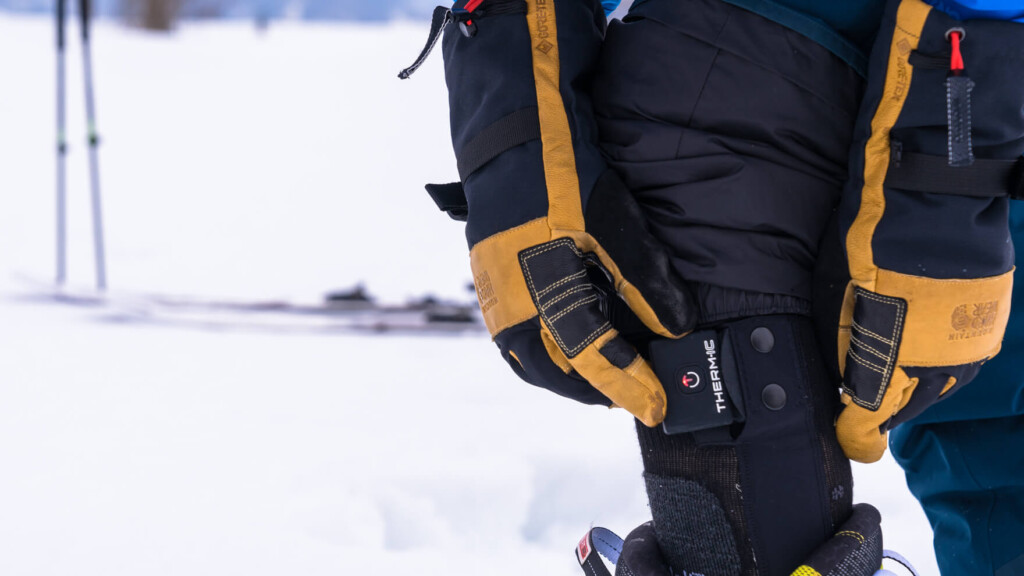
Has the frozen toes saved with forbidden battery heating socks? Therm-ic Power Socks Heat Uni V2 Review
morning. He comes out of his ready tent and puts his feet in his cold boots. No matter how much mountain experience I have, no matter how well I'm feeling well and full of energy, my toes in the morning, which have poor circulation due to these ice-cold boots, can be easily defeated.
Even if you are not as prone to cold as you would expect from the edges, winter mountains are often subjected to strong pressure from shoelaces and buckles, and your feet are exposed to freezing temperatures for a long time. If the situation gets a little worse, the cold will quickly become less sensitive, and in the worst case scenario, there is a risk of hypothermia or other symptoms. In fact, personally, I find that these toes are easier to bite than my hands, and my worries are urgent.
So last time I reviewed a rechargeable heat-generating gloves that I overcome with the power of technology in freezing winter hands, but this time I decided to try out the second installment of the rechargeable heat-generating series, a rechargeable heat-generating socks that warm your cold toes with the power of electricity.
table of contents
- Overcome the final stress of winter mountains, "cold toes"! ?
- Main features of Therm-ic Power Socks Heat Uni V2 + S-Pack 700 Battery
- Main Specifications and ratings
- I tried it on ski slopes and backcountry skiing (detailed review)
- Summary: I am satisfied with the heat generation function itself, but there is room for improvement in usability
Overcome the final stress of winter mountains, "cold toes"! ?
This time, I chose the Therm-ic Power Socks Heat Uni V2 (+ S-Pack 700 battery) from among the many heat-generating socks. Therm-ic has been a pioneer who has started with the development of heated insoles for ski boots, and has been creating ski and outdoor products that make full use of electric heat technology for over 20 years. Although the price is still not affordable, will these rechargeable heat-generating socks, which are the cutting edge of technology that continues to advance in dog-year, overcome the dangers and discomfort of winter mountain mountains? Is it actually practical? I'd like to report back soon.

Main features of Therm-ic Power Socks Heat Uni V2 + S-Pack 700 Battery
Recommended points
- High heat retention at maximum output
- Thin and less bulky
- Easy installation and hard to come off
- Cushioned shin
- Can be washed in hand wash mode
Interesting points
- Insufficient heat retention in weak mode, the most frequently used mode
- Low heat retention as a sock when switch is off
- The buttons are hidden by pants, making it difficult to operate
- The button part is easily erroneously operated due to pressure from the outside, making it difficult to check the current situation
- The socks are not stretchy, so it may not fit depending on the size of your foot.
- A difficult price to reach
- It is not highly durable (it is over if the electric wire part breaks down)
Main Specifications and ratings
| Specs | |
|---|---|
| Item name | Therm-ic Power Socks Heat Uni V2 + S Pack 700 Battery |
| Material (power socks) | Polyamide, acrylic, polypropylene, polyester, elastin |
| Accessories (S-Pack 700) | Dedicated USB charging cable |
| Adaptive temperature range | Low/0-10℃, Mid/-10-8℃, High/Jet lower |
| Battery life | Low/6-8 hours, Mid/4-5 hours, High/1 hour 45 minutes to 2 hours 15 minutes |
| evaluation | |
| Thermal insulation | ★★★★★ (★★☆☆☆ when the switch is off) |
| Comfort | ★★☆☆☆ |
| Support | ★★★☆☆ |
| Cushioning | ★★☆☆☆ |
| Quick drying | ★★★★☆ |
| Easy to use | ★★☆☆☆ |
I tried it on ski slopes and backcountry skiing (detailed review)
Comfort ★★★☆☆
At first glance, it was so thin that it made me think that there was an electric wire inside. I like the fact that it doesn't look out of place compared to regular socks. The long size up to the shin is perfect for skiing, and although it is slim overall, there is a certain amount of cushioning added to the shin, toe and heel, making careful consideration for areas where it is easily rubbed and loaded.
The heat transfer wire passes from the outside of the calves where the battery is set, through the heels and soles of the feet, and finally, a large swirl around the back of the toes. I'm grateful that the wire doesn't have any foreign objects, but unfortunately, the socks themselves lack the elasticity, and I, who is 26.3cm in size (just the boundary between size classifications), chose the size 26.5-28.0cm, and I had a slight excess of fabric.

Even when I wear socks and move my toes in small increments, I don't notice any stiffness or anything, and I don't feel any discomfort as a sock. The materials made up are made of quick-drying materials such as nylon, acrylic and polyester, so there is little need to worry about getting wet. However, for me, who always liked to wear thick, fluffy merino wool in winter, this thinness and lack of elasticity is quite unsatisfied, and socks with the switch turned off are totally cold and unreliable. This is a very negative point considering that there may be a breakdown or a battery run out in the harsh winter mountains.
Heat retention ★★★★★
Regardless of the comfort of the socks, let's proceed to verify the heat retention of the heating system, which is the biggest attraction of these socks.
As I mentioned earlier, the battery is attached to the outer side of the socks with snap buttons. This itself does not interfere with the boots, and is not particularly difficult or easy to come off, so it's not a problem for now.

Once the battery is installed, all you have to do is press and hold the button. This will cause fever to begin in weak mode. The heat is divided into three stages, and together with each duration, it is intended to be used in the temperature range as shown below.
- Low/0-10℃ (6-8 hours)
- Mid/-10~8℃ (4~5 hours)
- High/Jet temperature ~ (1 hour 45 minutes to 2 hours 15 minutes)
Before using it in the backcountry in January, when the cold weather was on the way, we tested it indoors to see how warm it would be. As soon as you turn on the switch, you can see that the back of your toes will gradually warm up. However, there is no significant change in warmth in other areas. Below is a picture taken with familiar thermography images. The top is the socks with the switched switched on in each mode, and the bottom is the socks with the switch turned off (the accuracy of the displayed temperature is not guaranteed, so it is only a comparison guide).

The following image shows a photo of my feet from the front after a while in a fever.
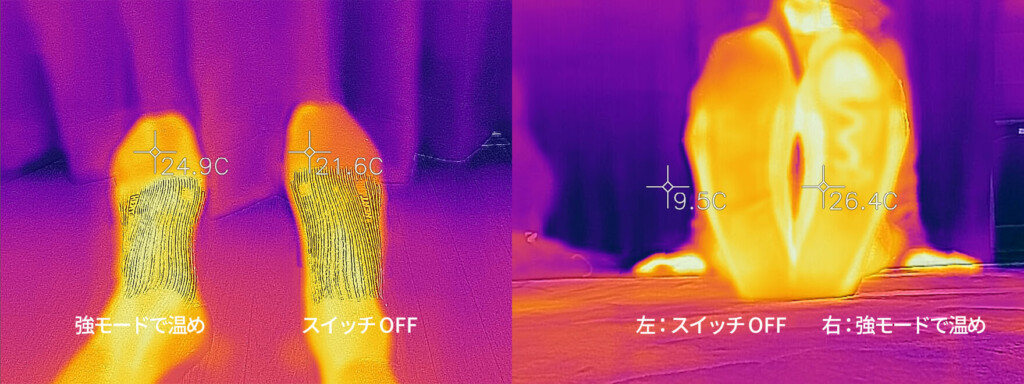
As can be seen from these figures, the part that is heated is mainly the spiral wire part on the back of the toes, and although the amount of heat generated by the other wire parts is not very large. This really makes it comfortable to ski in the middle of winter. There is a bit of anxiety.
Next, I decided to wear alternating "heating socks" and "merino wool ski socks" on the left and right sides to try using them in the actual field, as shown in the photo below.
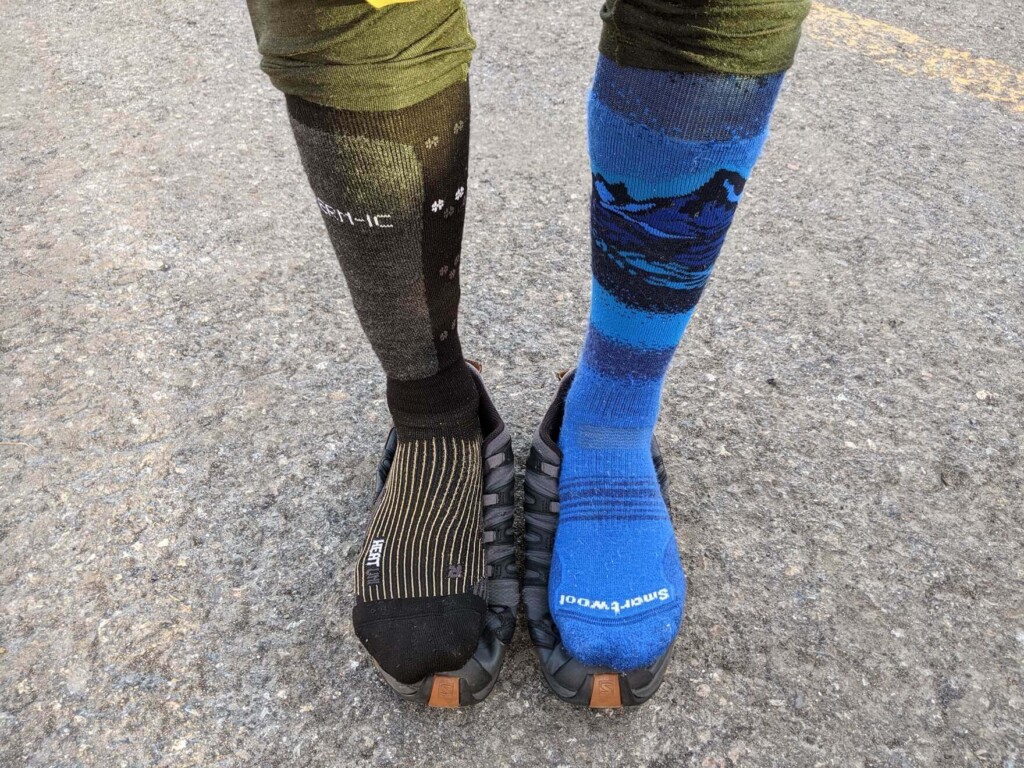
Of the three heat levels, considering the duration, there is no doubt that the level normally used is Low (6-8 hours). While changing into ski boots, I set the switch low. Each time you press the button, you can switch between low, mid, and high levels.
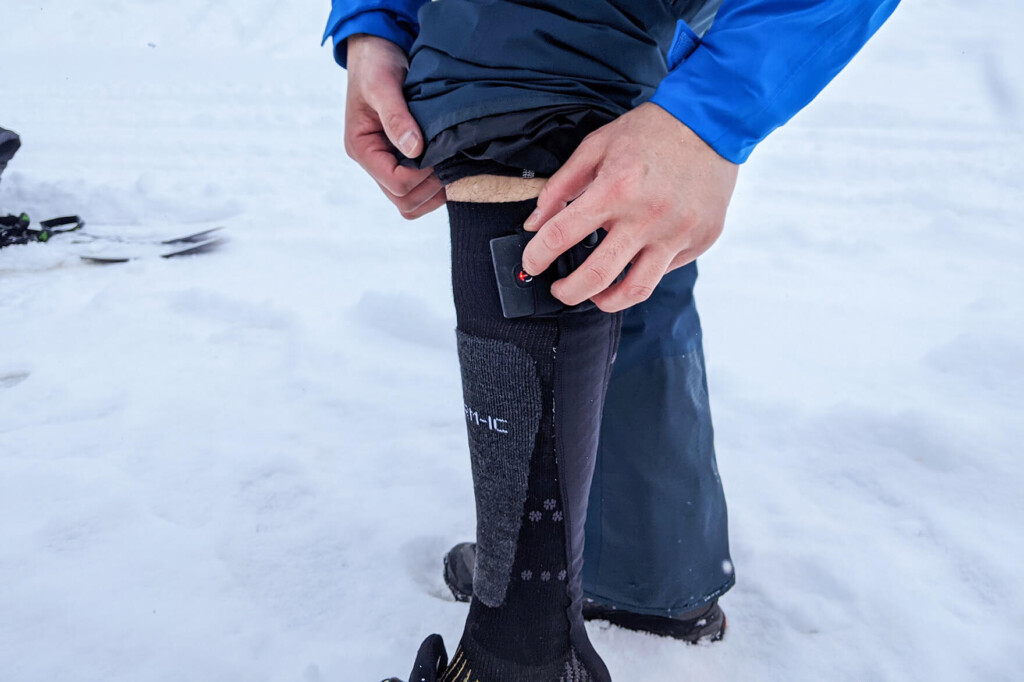
Incidentally, the three levels are determined by the flashing state of the button light (video below).
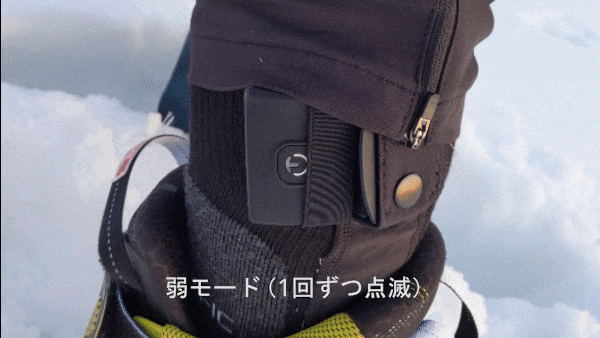
In writing this review, I compared the shoes in a wide range of weather, including backcountry with nice weather and ski resorts in the midst of a great cold wave.
First of all, as far as I continue to use it in Low mode, I honestly didn't think there was much difference in heat retention compared to the merino wool socks I've been wearing up until now.
As I was concerned, I don't think it's that different between thin socks with just a slight warming on the back of the toes and medium-thick merino wool socks that don't generate heat. It is true that my feet may not have been cold at temperatures above 0°C, but the pressure of my feet tightened tightly and sometimes my legs lost their senses, so I didn't feel any good enough.
If the temperature is below zero and the movement is slightly less, the feet will often get cold even when the temperature is low, so I'll be unable to resist and try switching to Mid or High mode. The inside of the shoe was warmed up well and kept me comfortable. This is just how comfortable it is, even if it's thick merino wool, it can't compete with it.
However, for users like me who wanted to use it as hard as they could during the harsh winter season, it is a pain to continue using the Mid mode, which lasts only 4-5 hours. the S-Pack 1200 a larger capacity than the battery pack (S-Pack 700) purchased this time , it is said to last up to 7 hours and 30 minutes in Mid mode. If you're considering using the service all day in the harsh cold, I'm a bit disappointed that I might have preferred to choose this one (although it's too expensive).
Other usability ★★☆☆☆
When using on skis, you have to roll up your pants and tights every time to check your current level or press the buttons (photo below).
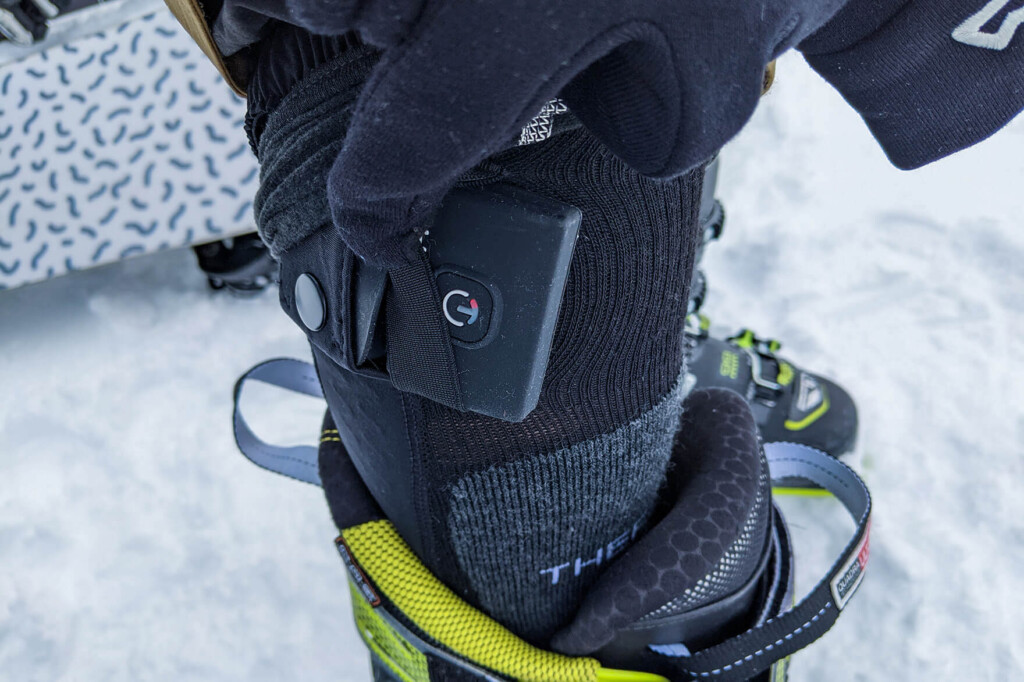
To be honest, this incompetent feeling is too bad. Plus, I don't know when I pressed this button, but before I knew it, I accidentally pressed it and changed mode without realizing it. When I think I was using it on a low level, but before I know it, it might turn into a mid and the battery runs out, I feel anxious and don't want to use it. Currently, overseas models are being released that allow you to switch modes from a smartphone app via Bluetooth connection, but this function should come as standard.
Summary: I am satisfied with the heat generation function itself, but there is room for improvement in usability
the Therm-ic Power Socks Heat Uni V2 definitely gives hope for outdoor enthusiasts who are cold-resistant to the edges. If you can use it for long periods of time in Mid (occasionally High) mode, you won't feel cold in most winter mountains.
However, I felt that there was still much room for improvement in the ease of use, such as the inability to use the Low mode in situations where it feels a bit cold, the comfort of the socks, and the button position. His quirks are strong and very sad.
If it were designed to make mode switching easy, you could save battery by switching between Mid and Low modes as needed, so it may not have been this much stress, but unfortunately the buttons are hidden by pants and tights, so once you set them, you won't be able to switch that easily.
For this reason, if you plan to use it for winter mountain climbing like you do, the S-Pack 700 battery may not have enough capacity and you may regret it despite the fact that it is not cheap. We recommend choosing a battery with an S-Pack of 1200 that can be used for long periods of time while still in the mid
Also, since the fabric had a weak stretch and the fit was not very good, I wore ultra-thin inner socks like the ones shown below underneath to adjust the size and add heat retention, and the fit was quite good.




 THERM-A-REST "Neoloft" & MSR "Habbahaba LT" Review: The age where you can carry the comfort of your bed with a backpack is finally here. Incredibly comfortable mountain tents and mats that keep weight down
THERM-A-REST "Neoloft" & MSR "Habbahaba LT" Review: The age where you can carry the comfort of your bed with a backpack is finally here. Incredibly comfortable mountain tents and mats that keep weight down Review: Therm-a-Rest Antares HD Sleeping Bag A comfortable sleeping bag with a touch of skill and skill that I got from "Sekaimon".
Review: Therm-a-Rest Antares HD Sleeping Bag A comfortable sleeping bag with a touch of skill and skill that I got from "Sekaimon". Review: Therm-a-Rest Vela HD Quilt Quilt quilted sleeping bag not released in Japan, obtained through "Sekaimon".
Review: Therm-a-Rest Vela HD Quilt Quilt quilted sleeping bag not released in Japan, obtained through "Sekaimon". itoix running socks tabi review: Try out various summer outdoor activities with "washi yarn" socks that don't get heat
itoix running socks tabi review: Try out various summer outdoor activities with "washi yarn" socks that don't get heat